#integritytree
Photo
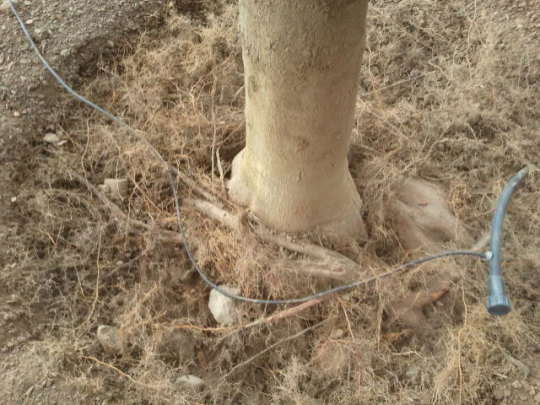
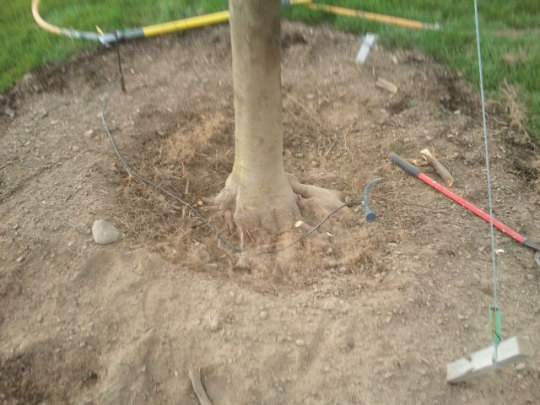
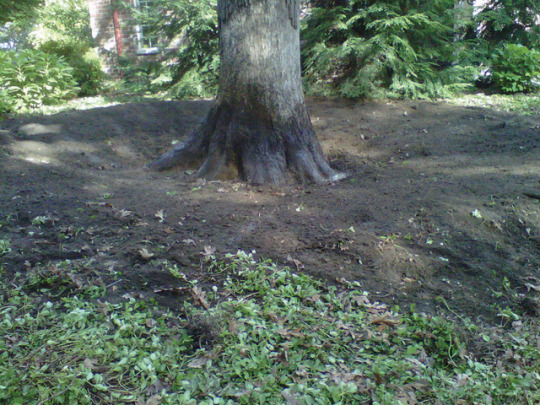
GIRDLING ROOT SYNDROME
Many times there can be problems below the soil where we can’t see. Certainly this is usually the case with most root problems of the trees. Girdling roots can be devastating to the tree if left untouched. So what should you look for?
Reduced of slowed growth
Thinning or lack of leaves at the top of the tree
Deformation of the natural shape of the crown
Trunk splitting or cracking at ground level
Lack of or no visible root flare present where the trunk enters the ground (like a telephone pole)
Most of the time these issues start to appear just as the tree starts to become an important part of the landscape. The reason for the delay is because it takes the roots some time to grow and cause these issues. Any type of tree can be susceptible to girdling root syndrome. The ones that we see most are Maples and Lindens. Early detection is very important in helping the tree survive. We have a tool that we use to do a root collar exam. This tool is called an airspade. An airspade is based on a compressed air system. It is used to move the soil away from the tree without damaging the roots of the tree. Once the soil is removed we are then able to selectively remove any roots that are girdling the tree.
Prevention is important. Avoid the “volcano mulching.” If the base of the tree has soil or mulch piled high around it, the roots will grow in that soil thus causing it to grow in a circling pattern. Another good preventative measure is performing a root collar exam on any tree that has been in the landscape for 5-10 years. This will check for soil buildup and will allow us to remove any circling roots before they become a problem. So the next time you are looking over your landscaping, please ask yourself, “Do I see a good root flare?” Or, does it look more like a telephone pole stuck in the ground? If you think that you have a problem please call us right away.
0 notes
Photo

ASIAN LONGHORNED BEETLE
Asian Longhorned Beetle (ALB) was first discovered in the United States in Brooklyn, New York, in Aug 1996.
ALB was later detected in Chicago, Illinois, in Jul 1998. In Oct 2002, the beetle was found in Hudson County, New Jersey, and then in Middlesex and Union Counties, New Jersey, in Aug 2004. In Aug 2008, ALB was discovered in Worcester County, Massachusetts, and in Jul 2010, ALB was found in Suffolk County, Massachusetts. In Jun 2011, ALB was detected in Clermont County, Ohio. However, in 2008, after the completion of control and regulatory activities, and following confirmation surveys, ALB was declared eradicated in Chicago, Illinois, and Hudson County, New Jersey.
Similarly, in 2011, ALB was declared eradicated from Islip, New York. So why should we be concerned?? Because of this pests diet. The Asian Longhorned Beetle has a long and growing list of hardwood host species in North America. While it seems to prefer maples and horse chestnut, it will readily attack yellow-poplar, willow, elm, mulberry, black locust, and several commercial fruit trees including pear and plum. ALB’s species preference leaves a majority of northern hardwood forests, western hardwood forests and most North American urban forests at risk.
0 notes
Photo
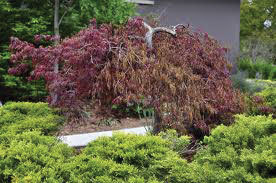
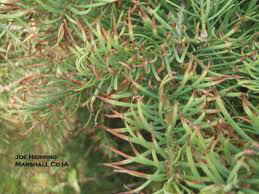

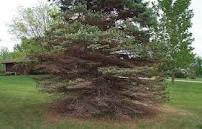
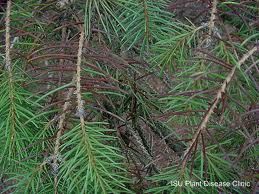
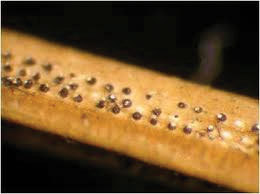

FROST & DISEASE DAMAGE
We were set up for the perfect storm for challenges in the landscape. In March, we had record high temperatures starting our growing season 4+ weeks ahead of schedule. With temperatures so high, plants and disease were both growing more rapid than previous years. This rapid advancement pushed our technicians into overtime to complete early season fungal/insect treatments. Just as everything started to look well, we had a hard frost in the first week in April. This isn’t out of the ordinary except that many of our plants were 4+ weeks ahead of schedule in their growth cycle. Tender new growth was already exposed and much of it was damaged. Typically no treatment is needed since they will shed the damaged leaves and sprout new ones.
Our summer drought conditions have finally broken but it has left its mark on some of the trees and shrubs in our area. Characteristic signs are leaves drying, starting from the outer edges. In extreme situations, you will see the entire leaf dry up and fall to the ground as if the season has changed early. These leaves are brown instead of turning color as they normally would. Many of these injured trees will recover however we are seeing some that are already completely dead.
Needlecast: There can be one of several fungal diseases lumped into this category. Most are treated with several spray applications to protect new growth from infection. It will take several growing seasons of protection before the plant fully recovers. This disease can overtake trees and will continue to spread if not treated.
Cytospora Canker: This disease takes over in the heat of summer since the tree is stressed. It will take over one limb at a time. Solution: (1) Remove dead or dying limbs and burn them. (2) Increase vigor of the tree. We have seen this disease stop since the tree’s stresses are reduced, but we have seen it completely take over and kill the tree. It is not treatable other than keeping the tree healthy.
Japanese Beetle Season:
We are at the beginning of the Japanese Beetle season. Make sure you are signed up to protect your plants this year. We will only shut down the appetite of the beetles and will not harm other beneficial insects. Some feeding on the plants will always occur as the beetles have to ingest some material before they will get the treatment into their system. If you have been in a heavily infested area (near heavily irrigated lawns where all the larvae feed underground), you should let our Arborists know so that they may need to add a more aggressive treatment as beetles start to feed.
0 notes
Photo
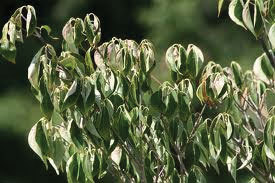
HELPING DROUGHT-STRESSED TREES
The big concern arborists have is what the extent of reaction to the great heat and drought of 2012 will be. Efforts to mitigate, ease, and compensate this reaction will increase the survival rate and reduce the loss of roots and crown that would occur otherwise.
Pruning is helpful in this effort. In addition to increasing tree health through a carefully considered Crown Cleaning Pruning that a certified arborist can do. This same pruning can reduce the tree’s demand for energy, water, and nutrients. Branches that are diseased, infested, damaged, rubbing, etc, necessitates the tree to devote resources to them—detracting from the energy needed by the tree for basic life functions. This energy is even more limiting during drought conditions. Removing these kinds of branches has a lasting beneficial effect for years to come. Healthy branches make food (energy) for the tree and should not be removed during drought.
Heat and drought reduce fine root mass immediately. Branch death follows and will likely continue and could easily initiate a decline spiral. Decline spirals are notorious for continuing until the tree is dead, deformed, or rendered too compromised. Proper pruning along with watering can play a role to help interrupt this decline tendency and save a valuable shade tree from having to be removed or from losing health or stature.
All of the methods that help ease drought stress and damage should be employed and are listed here:
Pruning to increase health and preserve energy (as described above).
Applying mulch over the root system to conserve moisture and create an environment that promotes feeder root replacement.
Watering widely beneath the tree once per week, giving (at least) one inch per week will help the tree retain roots and help the tree maintain its life functions.
Spring Fertilization including root biostimulants will help restore lost vigor by supplying needed nutrients and promoting feeder root replacement.
Mycorrhizal root inoculations (beneficial symbiotic fungi) are especially useful for increasing drought tolerance by increasing nutrient and water uptake.
Compost Tea root zone injection will increase beneficial soil life to help restore the root rhizosphere and the soil food web. This will also increase the performance of the root system and drought tolerance.
Certified Arborists are able to assess the conditions of each of your trees and help determine the best management plan. Take advantage of the knowledge, training, and experience our certified arborists have to help you and your landscape.
0 notes
Photo

HEALTHY SOIL
Below the surface of the soil lies a complex soil food web we will likely never see. Without it, much of the plant life we enjoy would not be able to exist. The soil food web consists of many organisms that are beneficial to the health of the soil. This beneficial web is plentiful in an undisturbed forest setting, but can be diminished or lacking in some of the soils we have around our homes where our trees are trying to exist.
Many practices done to soils can disturb this fragile soil food web. Things like compacting the soil, over watering, lawn treatments, removal of leaves and small branches, etc... can have major impacts on this fragile web. A healthy soil will need organisms like nematodes, beneficial fungi, bacteria, protozoa, arthropods, and certain other animals in order to maintain a favorable growing environment. These organisms play a critical role in nutrient cycling. Nutrient cycling is the process whereby plant materials are broken down into usable nutrients for plants to carry on life.
The soil food web also creates beneficial soil structures for trees. Soils are much more complex than just a mixture of sand, silt, and clay. It is also made up of soil spaces and many other physical structures that allow root growth and expansion.
0 notes
Photo

QUIT GETTING BIT!
If you’ve been outside either working in your yard or playing with your kids, you have enjoyed the wonderful mosquitos. Why is the infestation so bad? With the recent record rainfall and blast in warm temperatures, they have been able to multiply very quick. Integrity Tree Services treats for mosquitos and would love to help you with this nuisance insect.
Our treatment is safe for kids and pets. After treatment, you are required to let the product dry for 1 hour and then you can return outside to enjoy your investment you have worked so hard for.
Mosquitos lay up to 250 eggs at a time in still water and they hatch within 7-15 days. During the off-season, mosquitos can lay dormant for up to one year. If standing water is eliminated weekly, many mosquitos will be kept from breeding in the first place. So if you are anti-mosquito and want to abate these pesky insects, start by getting rid of breeding grounds in your yard.
Common mosquito breeding grounds:
Bird baths
Old tires
Open containers - cans, jars, bottles or anything that can hold as little as an ounce of water.
In fact, mosquitoes can breed in as little as a drop of water. Even recycle bins may have some open containers that can collect water. Don’t forget trash cans and trash can lids too!
Hollow trees
Water gardens & ponds - decorative ponds without fish and other large areas of standing water
Wading pools
Drainage ditches
Any area of standing water is a potential mosquito breeding ground!
0 notes
Photo


DEER & VOLE DAMAGE
In many areas, we see a great deal of damage from both deer and voles throughout the winter months. How can you recognize this type of damage?
DEER
Where deer populations are too high, you will see evidence of leaves and twigs disappearing on numerous plants from the ground up to 5-6’ high. It usually begins in late fall through winter as other food sources disappear. However, the worst areas can be hit year round. Deer seem to prefer Yew, Cedar, Holly (mostly evergreens) and the tender buds from many other landscape trees and shrubs.
Solutions:
For new landscaping, choose deer resistant plants.
Place netting over plants for protection.
Use deer repellents sprays.
Work with the Department of Natural Resources to introduce ways of reducing the deer population.
Erect deer fencing.
VOLES
Typically property owners do not notice that voles are destroying their prized trees/shrubs because they like to feed on the bark of the plant that’s out-of-sight. The damage will always be at the base of the tree or on the limbs/trunk of some plants as the snow begins to cover them giving the voles the privacy they like. In most cases, we receive a call in the spring that the tree/shrub is not looking very well. By that time, the damage is done and very often we have to remove it and replace it, costing our clients hundreds of dollars.
Solutions:
Keep ground cover 6-12” from the trunks of trees/shrubs.
Do not pile mulch above the root flare of trees/shrubs.
Monitor your landscape in fall and winter for early signs of damage.
Use well placed bait and traps.
Both deer and voles can be difficult to control.
If you suspect either of these issues on your property, contact us immediately. We will send an arborist out to help you develop a realistic plan to gain back control of your landscape. Do not hesitate...your investment could be at risk.
0 notes
Photo
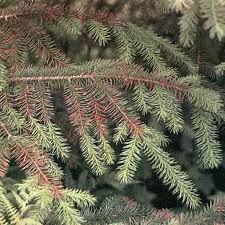
HOW TO SPOT FUNGUS IN YOUR LANDSCAPE
With the spring finally here, we’re constantly thinking fungus. A wet spring brings about new growth coming on the trees, so we have to think about treating these trees for fungus. The trees that have struggled the last few years are evergreens, mainly spruce trees. Many of the trees we are seeing decline are the older, more mature trees. New research is showing that there is another type of fungal issue to watch for other than needle cast.
Phomopsis is a canker causing fungal pathogen known to cause branch death. We now know that a group of Phomopsis strains of unknown species are at the center of the current landscape spruce problems that we are now calling “Phomopsis spruce decline”. Normally, Phomopsis, a fungal pathogen, is only found on young trees in nurseries and on tree farms, including Christmas tree farms. For some unknown reason, this pathogenic fungus has moved out of the nurseries and tree farms and is now causing mature tree defoliation, branch death, and, in some rare cases, tree death. Phomopsis appears to cause these symptoms by establishing cankers (bark infections) on older branches, usually on the lower half of the tree. The cankers can be found somewhere on the large branches near the dying small branches extending from the branch. We have also found trees with severe defoliation throughout the trees but without too much branch death (terminal buds are still alive). This would look very similar to a true needle cast disease. Keep in mind that on spruce there are other cankers caused by other pathogenic fungi, such as Cytospora and Diplodia, but the predominant canker-causing pathogen currently appears to be Phomopsis. It may appear as a needle cast problem, but it is a canker disease and finding the canker without skinning all of the thin bark from the branch
is difficult.
There is not much outward appearance to the canker infection. That is, there is little in the way of a sunken canker that can be observed without removing the bark. What we believe is occurring is a fungal infection that expands around the branch, girdling the current year’s sap-conducting vessels or phloem. As the fungus grows deeper into the resinous branch, the branch begins losing connections with the main stem and the needles begin to drop from the older portions of the branch outward. It is similar to cutting a branch off a tree and putting it in a vase of water. It will stay fresh for a while but, sooner or later, the nutrients and water resources are lost and the branch begins to fail and finally dies. This is why we are seeing so many spruce trees dropping needles which is followed by branch death. The progression of the symptoms will depend on how much of the branch is girdled by the canker caused by the Phomopsis infection and how long the infection has been in present on the tree.
0 notes
Text
PRUNING
The primary objective of pruning young trees is to develop a framework of sturdy, well-spaced branches on a strong trunk. Good branch structure, proper form, and tree strength all develop with training pruning.
Pruning done early in a tree’s life removes weak branches and corrects form when branches are relatively small. This reduces the size of pruning wounds, which results in faster closure and less opportunity for decay.
Properly pruned and trained trees will live significantly longer, are healthier, and require less corrective pruning later. They will also be less susceptible to storm damage due to improved structure, and are therefore safer.
Pruning is especially critical in the first 15-20 years of a tree’s life. The pruning cycle should begin 2-3 years after planting and should be done at regular intervals. The pruning process removes portions of the tree to correct or maintain tree structure and form. Every cut has the potential to change the growth of the tree. Good pruning technique removes structurally weak branches while maintaining the natural form of the tree and the branch collar.
The goals of early structural pruning are trunk development and branch positioning.
Efforts are concentrated on removing crossing, rubbing, broken, diseased and weak-angled branches in the upper portion of the tree. We strive to eliminate double leaders and basal sprouts, selecting and developing one main leader on most species. “3-D” pruning is done to remove dead, damaged, and diseased portions.
The best form for most young trees is a single dominant leader growing upward. This leader is not pruned back nor are secondary branches allowed to outgrow the leader. Double leads, known as co-dominant stems, can lead to structural weakness, so it is best to remove these while the tree is young.
Temporary branches are not part of a mature tree’s crown, but do contribute to trunk development and protect the trunk from sun and mechanical injury. Temporary branches are in the lower third of the crown. They will eventually be removed when they become an inch or larger. They should not obstruct or compete with selected permanent branches.
Permanent branch selection is determined by the tree’s function and location in the landscape. Proper selection and establishment of these branches is a critical part of pruning. Branches selected as permanent branches must be well spaced along the trunk. Branches with a much narrower angle of attachment than is typical of the species are removed. All branches should be less than half the trunk diameter.
Remember, pruning is an ongoing process to be done regularly throughout a tree’s life. Proper training pruning will get your tree off to the best start. Pruning is both an art and a science. Let the certified arborists at Integrity Tree Services make your trees be the best they can be.
We know the growth habit of a tree before beginning the pruning process. Over-thinning and over-pruning are avoided. The leaves of each branch must manufacture enough food to keep that branch alive, as well as contribute to growth of the trunk and roots. We strive to remove no more than 25% of the foliage–10-20% maximum is usually the goal.
Schedule an appointment today with one of our certified arborists!
0 notes
Photo
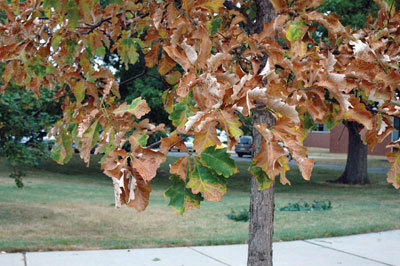
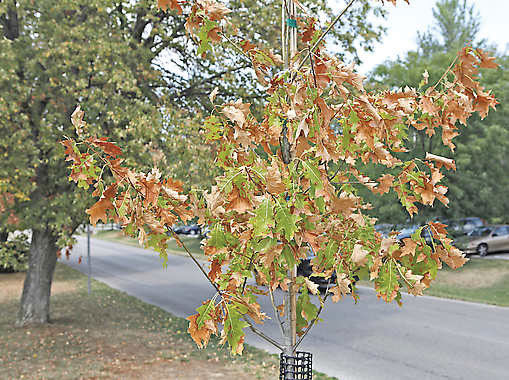
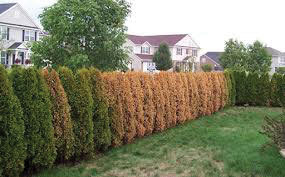
WATER: THE ELIXIR OF LIFE
Water is the greatest component of most living things. We know how revitalizing a drink of water can be when thirsty. Water has been found to be the most limiting factor for plant growth. The results of lack of water may not show up immediately on large trees, but will become evident in the next few years.
Tree systems shut down under dry conditions. Water uptake and photosynthesis are reduced. Fine roots desiccate and die. A dangerous spiral of decline starts.
Adequate water can stop this spiral. Most trees require the equivalent of an inch of water per week. If nature does not provide enough water, you will need to supply supplemental water. Proper watering will be crucial for your tree’s health in 2014 and the future.
Water deep enough to soak the soil to a 6” depth and repeat only when the top 3” become dry. This promotes a deeper, healthier root system. Irrigation systems are set up primarily for turf grass (which can recover more readily from drought than trees, and is cheaper to replace). These irrigation systems produce a very shallow watering several times a week. Do not depend on your irrigation system to properly water trees.
Always check soil moisture before watering. Trees’ roots can be drowned with too much water. Water where it will do the most good, at the roots. Start watering a few feet from the trunk to well beyond the drip line of the tree. Avoid wetting the foliage. Mulch with organic materials such as bark wood chips to conserve moisture and moderate fluctuations.
Proper watering will help maintain your valuable trees and avoid stressing them. If you need guidance, the certified arborists at Integrity Tree Services are available to assist and guide you with tree care.
0 notes
Photo
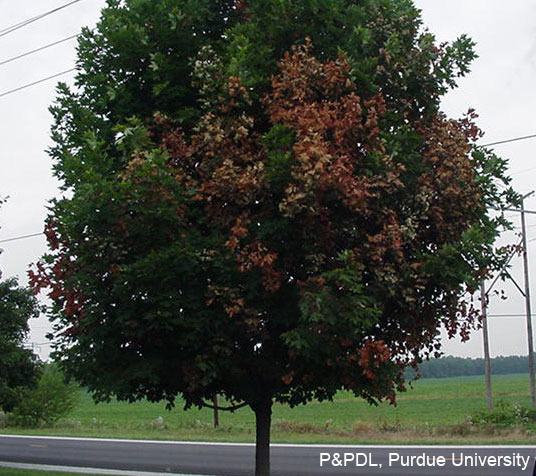
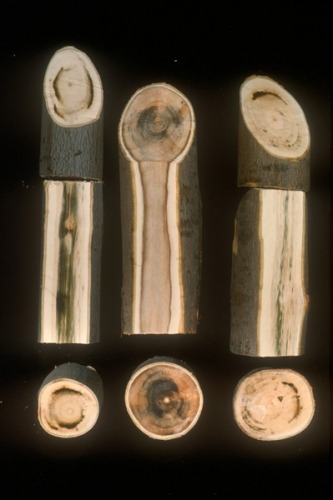
WHAT IS VERTICILLIUM WILT?
Verticillium wilt is a fungal disease that attacks many tree species. Common symptoms include wilting and browning leaves, falling leaves and quite commonly, a whole side of a tree or a single branch of a tree dying off. Checking the sapwood under the bark of the infected branches, brown streaks may be observed. These symptoms are caused by a soil-borne fungus Verticillium albo-atrum, which begins in the root system and travels through the vascular system of the tree. This causes blockage and prevents water and nutrients from reaching all of the branches. The tree responds to this infiltration by plugging the infected tissues and this increases the blockage of water and nutrients, thus causing leaf wilting and branch death. Symptoms commonly occur in the middle of summer when the climate is dry and hot.
There is no fungicide treatment for Verticillium wilt. Once a tree or shrub is infected with Verticillium wilt, it will eventually die. Resistant species should be planted in place of it after it is removed. Observe a tree if it begins to develops symptoms, as opposed to immediately removing it. Trimming out the dead branches as well as keeping the tree watered and fertilized may delay the infection. Once a tree is infected, however, there is no curing it. The fungus that causes Verticillium wilt can affect many tree species, however yews and conifers are not affected. What is more, the fungus can thrive in the soil for many years, therefore if a maple for instance dies of Verticillium wilt and if the maple is removed, another maple should not be planted in its place, for the fungus is still present in the soil. Common susceptible trees species are ash, boxwood, catalpa, cherry, elm, lilac, magnolia, maple, redbud, serviceberry and tulip trees. Common resistant trees are apple, beech, birch, ginkgo, hornbeam, linden, oak, pear, poplar, rhododendron, sweet gum and walnut. For a complete list of Verticillium wilt susceptible and resistant plants, please check online.
A tree can become more susceptible to Verticillium wilt if environmental conditions are poor, such as if the tree is experiencing drought, girdling roots, compaction, scorch or nutrient deficiency. Any stress on a tree can more readily allow infection to take root or can cause a tree to decline more quickly. Depending on the tree and conditions, a tree may die in a single growing season from Verticillium wilt or a tree may decline over the course of many years.
If you think Verticillium wilt is present in your landscape, please call (616) 301-1300 ext 118 to schedule an appointment with one of our certified arborists. To make sure a tree is suffering from Verticillium wilt, Integrity can take a plant sample and send it to the Michigan State University plant diagnostic lab in order to get it tested. The sample must come from the infected area of the tree, as the fungus is not usually throughout the whole tree. Several different branches about 1 inch diameter thick of live tissue should be taken to ensure accuracy. The test will cost $75 and will take 1-2 weeks for results to come back.
0 notes
Photo


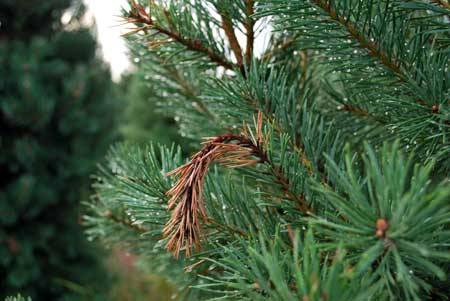
PLANT FUNGAL DISEASES
Integrity Tree Services treats for a variety of plant fungal diseases such as anthracnose, needle cast, apple scab, powdery mildew, cedar apple rust and tip blight. All of these treatments begin to take place in early spring, before it is warm enough to have airborne fungal spores. As Tree & Shrub Care proposal renewals are filtering in for the 2015 season, customers are making sure to sign up for fungicide treatments early to ensure proper timing of treatment. Timing is very important when dealing with fungal pests and most treatments occur in sets of three applications between 10 and 14 days apart.
If you think part of your landscape is subject to fungal diseases, give us a call and we will come out for a free estimate. We will diagnose the fungal issue, prescribe a treatment and execute it depending on the time of season. If a fungal problem is noticed late summer, it is best to wait until early spring the following year for the fungicides to be effective. Not all fungi are bad, but many can cause unsightly appearances and can deteriorate your landscape over time.
Some simple tips in deciphering if your landscape plants have fungal problems:
Do leaves or stems have black/brown spots or patches?
While looking up close, do the needles of the evergreens have tiny black spots?
Is there a white powdery or sooty appearance on the leaves and buds?
Are the tips of the plant wilted and dying?
Are there gelatinous gobs oozing from the stems and leaves/needles?
Is the interior of the plant dying?
If you witness any of these symptoms or suspect fungal problems, let us know and we will be happy to assist you. Many of these issues can stem from overwatering (such as a sprinkler hitting trees and shrubs every day), dark and thick plant interiors (such as a tree that has not been pruned or thinned-out lately), or if a plant is under stress or is in poor health to begin with.
There are some fungal problems that will persist and deteriorate a tree year after year, such as needle cast. These types of fungal diseases are necessary to treat with a fungicide. However, as a reminder, there is always fungus present in the natural landscape. It is possible for a tree or shrub to have a fungal disease but be hearty and healthy enough to withstand it. We can assist in determining if a fungal problem exists and if remedies need to occur in order to sustain the life of your landscape plants.
0 notes
Photo
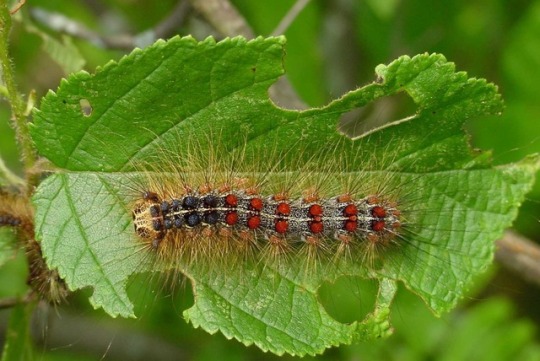
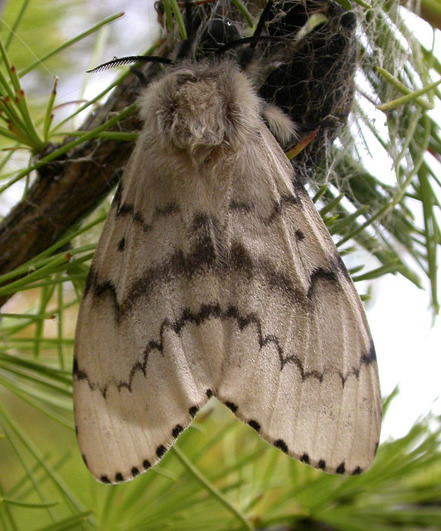
GYPSY MOTHS
An invasive species from Europe and Asia, the gypsy moth was introduced by a scientist living in Massachusetts in 1869, who was interested in breeding silkworms. Not long after, some of the insects escaped and began to establish themselves (USDAFS 1989). Millions of pure forests stands have been decimated by this little caterpillar. Of course, as many homeowners may already know, they do not limit themselves to natural forest stands. They are happy to enter our yards as well.
In the early spring, gypsy moth caterpillars hatch from their tan, oval-shaped egg sack. Hundreds or up to a thousand tiny caterpillars crawl from each egg sack and make their way to greenery, often using silken threads so they may be dispersed by the wind. As the caterpillars grow in size in the next several weeks, the amount of food they need to sustain themselves increases exponentially. Seemingly overnight, whole areas of the canopy of a mature tree are defoliated. That is when Integrity Tree Services receives phone calls.
Unfortunately many times with gypsy moth caterpillars, homeowners notice them only after the bulk of the damage is done. Colossal trees and forests can be put to waste in infested areas after thousands and thousands of caterpillars have their fill. Beginning at just centimeters long, these caterpillars quickly grow to about 2 inches in a matter of weeks. Once the caterpillars are identified, treating for them is not the tricky part, it is noticing the infestation before the majority of feeding damage occurs.
A female gypsy moth lays an egg sack in late summertime and dies soon after. The egg sack remains over the winter and once the climate is right in the spring, the eggs hatch and the caterpillars emerge. The caterpillars reach maturity after roughly 7 weeks in mid-summer, from there they pupate. The pupation stage lasts for 1-2 weeks, and then a moth will emerge. Once a moth, the brown male moths will fly around in search of flightless, white females (Johnson & Lyon, 1991). It can be apparent where there has been an infestation of gypsy moth caterpillars during mid to late summer, for one will see dozens of brown gypsy moth males, fluttering all around.
Be sure to monitor your landscape in May of 2017, when the gypsy moth caterpillars grow large enough to be noticed. Also keep an eye out for the egg sacks, which are usually laid in August. If found and if within reach, destroying them with a stick is affective on a small scale. The gypsy moth caterpillars are easier to identify when they are larger, right before they pupate. Look out for fuzzy caterpillars with blue and red spots. There are other caterpillars, which congregate in numbers, which could be mistaken for gypsy moth caterpillars, such as eastern tent caterpillars and fall webworms.
If you think you may have a gypsy moth caterpillar infestation starting, feel free to take a picture and email it to [email protected] in order to receive confirmation of the infestation. If you are unable to send a photo, feel free to call (616) 301-1300 extension 118 to schedule a free estimate with one of our certified arborists.
Most of the time, we can get our technicians to the scene same-day. Fortunately, there are some natural defenses present in the environment, which help control caterpillar populations. There is a soil-born fungus, which kills a large number of caterpillars, there is also a virus, and there are predators including, birds, parasitic wasps, flies and beetles (Johnson & Lyon 1991).
Be on the lookout for gypsy moth caterpillars next spring! If you see them, call Integrity Tree Services right away!
0 notes
Photo

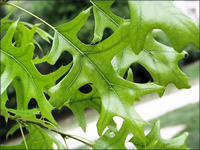
SIGNS OF NUTRIENT DEFICIENCY
Now that new leaves and needles are out, you may be noticing something peculiar about them. It is common for trees and shrubs to experience nutrient deficiency, which is noticeable from the color or stunted size of the leaves or needles. Whether the tree or shrub is low on iron, manganese or any other type of micronutrient, more than likely you will be able to identify this by observing the leaves.
A micronutrient is required by plants in very small quantities, as opposed to macronutrients, such as nitrogen, phosphorous, calcium or sulfur, which are required by plants in large quantities. Plant tissues are made up of mostly macronutrients such as nitrogen, phosphorous and the others, therefore they are required by the plants in larger quantities. Micronutrients are minerals in the soil that are also required for healthy, stable plants. Micronutrients such as iron, manganese, silicon, copper and zinc are commonly present in the soil where a landscape plant is experiencing signs of nutrient deficiency, it is simply that when a soil has a high pH (is more alkaline as opposed to acidic), these micronutrients are in a form that cannot be taken up by plant roots.
Testing the soil pH can help determine whether or not a specific soil type will be suitable to easily sustain a tree or shrub. If a landscape plant is already established and is showing signs of nutrient deficiency, there are several fertilization techniques (micronutrient and macronutrient) that Integrity Tree offers that can temporarily strengthen the health of your plants. Temporary, meaning that the treatment will most likely be needed again the following season, as the micronutrient is applied for the plant and does not change the overall soil pH.
A few common micronutrient deficiencies are iron chlorosis and manganese deficiency. The leaves will be yellowing and will be greener along the leaf veins. The leaves or needles could also be stunted, not being able to grow to their full potential because they do not have the proper nutrients.
If you think your landscape plants may be experiencing nutrient deficiencies, please call our office at 616-301-1300. We offer soil testing and can explain what fertilizer and fertilization technique would be best for your landscape.
0 notes
Photo

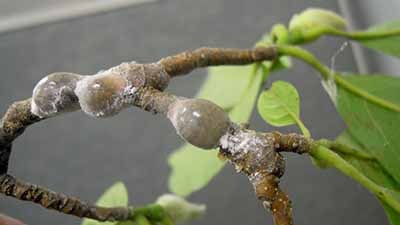
SCALE INSECTS
To the untrained eye, a tree or shrub may look unhealthy or unsightly for no apparent reason. Upon closer inspection however, the culprit may be present in plain sight.
Scales are tiny insects that feed on plant sap, and certain species of scale may injure plants. In large numbers, scales may cause significant damage to trees or shrubs if left untreated. Because of their miniscule size, these insects may go unnoticed until it may be too late to revive a landscape plant. Monitoring visits are important in this regard, as technicians will visit customer landscapes with the changing seasons in order to be on the lookout for cryptic threats such as these.
There are two main types of scales, armored scales and soft scales. Armored scales produce a waxy, hard coating overtop of their bodies acting like a shell, protecting the insect from the environment. Euonymus scale, pine needle scale and oystershell sales are a few examples of armored scale. Armored scales can have several generations a year and usually spend the winter as eggs, first instar nymphs (first growth stage), or as a mature female (depending on species and location). Eggs usually hatch late May or early June. Once scales hatch from their eggs they are called crawlers. Unlike the adult scales, the crawlers are mobile insects which travel to the leaves to feed during the summer and migrate to the twig before the leaves drop in the fall. Using a long mouthpart called a stylet, which is usually 6 to 8 times as long as the insect itself, the straw-like stylet is inserted into the plant tissue to feed on sap. Once the crawlers produce the waxy, armored coating, they lose their legs and become immobile. If a plant is heavily infested with scale, not enough sap is left for the plant to maintain proper vigor for growing and the plant will begin to decline.
Soft scales, appropriately named are soft compared to armored scale, they do not produce a shell-like coating, merely a waxy, penetrable coating. They are generally larger in size than armored scales. A few examples of soft scales are cottony maple scale, magnolia scale and lecanium scale. Soft scales usually have only one generation per year and generally spend the winter as second instar nymphs (second growth stage), and remain attached to twigs. They complete their development in the spring when the females lay eggs. Soft scale eggs hatch later in the year than armored scales, usually in late June or early July. When soft scales feed on plant sap, also with a stylet, they produce a sugary liquid called honeydew. The honeydew attracts ants and flies. If scales are in large in number, there can be so many wounds on the tree or shrub that sap can drip, creating sticky sidewalks and landscapes. A black fungus called sooty mold eventually also sets in to feed on the honeydew.
Here at Integrity Tree Services, we have had many phone calls from Tree & Shrub Care customers regarding their trees or shrubs looking unhealthy. Occasionally, upon inspection the culprit for the plants’ decline is scale. The significance in the scale infestation depends on the species of scale, the size of the population, the species and value of the plant the scales are affecting as well as other environmental factors. Not all scales are harmful to landscape plants. Scales usually feed on plants that are already stressed, however, it is perfectly normal for a tree or shrub in the landscape to house some scale. Scales have many predators in the landscape such as parasitic wasps, ants, lacewings, ladybugs, beetles and mites; an abundance of predators may not warrant chemical action. Sometimes, if simply a branch is infested, just pruning the branch can be enough to prevent infestation.
If a landscape plant has significant value, is heavily infested with scale and if natural predators are not abundant in the landscape, chemical control can help fend off scales. If you’re suspicious that scales are a reason for the decline of you tree or shrub, please feel free to call us to set up a free estimate with one of our certified arborists. Call (616) 301-1300 extension 118 to schedule an appointment. We can help determine if scale is present, if it is harmful to your landscape and if chemical treatments could be beneficial to the health of your plant. As usual, the easiest method to prevent infestation is prevention. Keeping your landscape plants healthy with proper irrigation and maintaining optimum, growing conditions can make your plants more resistant to insect infestation.
0 notes